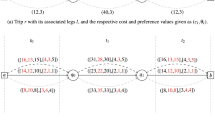Abstract
Car pooling is one method that can be easily instituted and can help to resolve a variety of problems that continue to plague urban areas, ranging from energy demands and traffic congestion to environmental pollution. Although car pooling is becoming more common, in practice, participant matching results are still being obtained by an inefficient manual approach, which may possibly result in an inferior solution. In the past, when car pooling studies have been done the problem has been treated as either a to-work problem (from different origins to the same destination) or return-from-work problem (from the same origin to different destinations). However, in this study we employ a time-space network flow technique to develop a model for the many-to-many car pooling problem with multiple vehicle types and person types. The model is formulated as an integer multiple commodity network flow problem. Since real problem sizes can be huge, it could be difficult to find optimal solutions within a reasonable period of time. Therefore, we develop a solution algorithm based on Lagrangian relaxation, a subgradient method, and a heuristic for the upper bound solution, to solve the model. To test how well the model and the solution algorithm can be applied to real world, we randomly generated several examples based upon data reported from a past study carried out in northern Taiwan, on which we performed numerical tests. The test results show the effectiveness of the proposed model and solution algorithm.
Similar content being viewed by others
References
Baldacci, R., Maniezzo, V., & Mingozzi, A. (2004). An exact method for the car pooling problem based on Lagrangian column generation. Operations Research, 52(3), 422–439.
Colorni, A., & Righini, G. (2001). Modeling and optimizing dynamic dial-a-ride problems. International Transactions in Operational Research, 8, 155–166.
Coppersmith, D., Nowicki, T. J., Paleologo, G. A., Tresser, C., & Wu, C. W. (2005). The optimality of the on-line greedy algorithm in carpool and chairman assignment problems (IBM Research Report). RC23721.
Cordeau, J. F. (2006). A Branch-and-cut algorithm for the dial-a-ride problem. Operations Research, 54, 573–586.
Cordeau, J. F., & Laporte, G. (2003a). A tabu search heuristic for the static multi-vehicle dial-a-ride problem. Transportation Research, Part B, 37, 579–594.
Cordeau, J. F., & Laporte, G. (2003b). The dial-a-ride problem (DARP): variants, modeling issues and algorithms. 4OR, 1, 89–101.
Cordeau, J. F., & Laporte, G. (2007). The dial-a-ride problem: models and algorithms. Annals of Operation Research, 153, 29–46.
Coslovich, L., Pesenti, R., & Ukovich, W. (2006). A two-phase insertion technique of unexpected customers for a dynamic dial-a-ride problem. European Journal of Operational Research, 175, 1605–1615.
Diana, M., & Dessouky, M. M. (2004). A new regret insertion heuristic for solving large-scale dial-a-ride problems with time windows. Transportation Research, Part B, 38, 539–557.
Fagin, R., & Williams, J. H. (1983). A fair carpool scheduling algorithm. IBM Journal of Research & Development, 27(2), 133–139.
Ferrari, E., Manzini, R., Pareschi, A., Persona, A., & Regattieri, A. (2003). The car pooling problem: Heuristic algorithms based on savings functions. Journal of Advanced Transportation, 37, 243–272.
Fisher, M. L. (1981). The Lagrangian relaxation method for solving integer programming problem. Management Science, 27, 1–18.
Garey, M. R., & Johnson, D. S. (1979). Computers and intractability: a guide to the theory of NP-completeness. San Francisco: Freeman.
Guo, Y. J. (2003). Trip cost urban transportation. Master’s thesis, National Taiwan University, Taiwan, ROC.
Jørgensen, R. M., Larsen, J., & Bergvinsdottir, K. B. (2007). Solving the dial-a-ride problem using genetic algorithms. The Journal of the Operational Research Society, 58, 1321–1331.
Melachrinoudis, E., Ilhan, A. B., & Min, H. (2007). A dial-a-ride problem for client transportation in a healthcare organization. Computers & Operations Research, 34, 742–759.
Naor, M. (2005). On fairness in the carpool problem. Journal of Algorithms, 55, 93–98.
Papadimitriou, C., & Steiglitz, K. (1982). Combinatorial optimization: algorithms and complexity. Englewood Cliffs: Prentice-Hall.
Rekiek, B., Delchambre, A., & Saleh, H. A. (2005). Handicapped person transportation: an application of the grouping genetic algorithm. Engineering Applications of Artificial Intelligence, 19, 511–520.
Ropke, S., Cordeau, J. F., & Laporte, G. (2007). Models and branch-and-cut algorithms for pickup and delivery problems with time windows. Networks, 49, 258–272.
Teodorovic, D., & Radivojevic, G. (2000). A fuzzy logic approach to dynamic dial-a-ride problem. Fuzzy Sets and Systems, 116, 23–33.
Wolfler-Calvo, R., & Colorni, A. (2007). An effective and fast heuristic for the dial-a-ride problem. 4OR, 5, 61–73.
Wolfler-Calvo, R., Luigi, F. L., Haastrup, P., & Maniezzo, V. (2004). A distributed geographic information system for the daily car pooling problem. Computers & Operations Research, 31, 2263–2278.
Wong, K. I., & Bell, M. G. H. (2006). Solution of the dial-a-ride problem with multi-dimensional capacity constraints. International Transactions in Operational Research, 13, 195–208.
Xiang, Z., Chu, C., & Chen, H. (2006). A fast heuristic for solving a large-scale static dial-a-ride problem under complex constraints. European Journal of Operational Research, 174, 1117–1139.
Yan, S. (1996). Approximating reduced costs under degeneracy in a network flow problem with side constraints. Networks, 27, 267–278.
Yan, S., & Shih, Y. L. (2009). Optimal scheduling of emergency roadway repair and subsequent relief distribution. Computers & Operations Research, 36(6), 2049–2065.
Yan, S., & Yang, D.H. (1996). A decision support framework for handling schedule perturbation. Transportation Research, Part B, 30(6), 405–419.
Yan, S., & Young, H. F. (1996). A decision support framework for multi-fleet routing and multi-stop flight scheduling. Transportation Research, Part A, 30(5), 379–398.
Yan, S., Chen, S. C., & Chen, C. H. (2006b). Air cargo fleet routing and timetable setting with multiple on-time demands. Transportation Research, Part E, 42(5), 409–430.
Yan, S., Lo, C. T., & Shih, Y. L. (2006a). A cargo container loading plan model and solution algorithm for international air express carriers. Transportation Planning and Technology, 29(6), 445–470.
Author information
Authors and Affiliations
Corresponding author
Rights and permissions
About this article
Cite this article
Yan, S., Chen, CY. An optimization model and a solution algorithm for the many-to-many car pooling problem. Ann Oper Res 191, 37–71 (2011). https://doi.org/10.1007/s10479-011-0948-6
Published:
Issue Date:
DOI: https://doi.org/10.1007/s10479-011-0948-6




